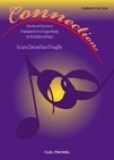Making Musical Connections with a Middle School Band
 One of the most elusive aspects of performance in the middle school band is the students’ ability to understand how to make musical connections—that is, the relationships and performance implications of notes, chords, etc. within a phrase. In the initial and middle stages of learning how to play a wind instrument, students seem to perceive that notes are to be played one at a time, sometimes even with short puffs of air, destroying any potential for maintaining a horizontal musical line, and demonstrating the inability to grasp the musical intent of the phrase. This same sophistication is necessary for performers in vertical chord structures, regarding balance, blend, and intonation; but often the quest for vertical perfection creates a setting where the student develops a disregard for horizontal/linear playing. Learning to play an elegant well-connected musical line is something that even professionals struggle to master. This is the true artistry of the musical performing art and what separates a live human performance from that of computer generated music.
One of the most elusive aspects of performance in the middle school band is the students’ ability to understand how to make musical connections—that is, the relationships and performance implications of notes, chords, etc. within a phrase. In the initial and middle stages of learning how to play a wind instrument, students seem to perceive that notes are to be played one at a time, sometimes even with short puffs of air, destroying any potential for maintaining a horizontal musical line, and demonstrating the inability to grasp the musical intent of the phrase. This same sophistication is necessary for performers in vertical chord structures, regarding balance, blend, and intonation; but often the quest for vertical perfection creates a setting where the student develops a disregard for horizontal/linear playing. Learning to play an elegant well-connected musical line is something that even professionals struggle to master. This is the true artistry of the musical performing art and what separates a live human performance from that of computer generated music.
Teaching students that even simple rhythmic patterns in music have musical intent is the starting point. It is my experience that every great player and every great band starts with long tones, because they are in fact difficult to master. These long tones, however should not be done as mindless drills with no emphasis on musical integrity. Every note that a student plays should be used as an avenue to improve their musicianship. I suggest making young students start out by playing long tones with a slight lift or crescendo, so that the note has life and direction. I always tell young students – “Any note longer than a quarter note has to go somewhere (crescendo) or come from someplace (decrescendo).” Start by making it a habit for even long tones to have musical life and intensity. Also, make sure to teach students the real lengths of notes. What I mean by this, is that a whole note for example does not stop on the fourth beat, but it continues until one of the next measure. I like to say, “play until you think of five.” This goes for all other note values as well, they should go until the next beat.
Next, teach students that different beats of the measure have different stresses. For example, in 4/4 time, generally beats 1 and 3 are stronger beats and 2 and 4 weaker beats. Again, we are trying to avoid a monotone sound of every note having the same weight and same musical inflection. It is boring to listen to! Each note means something in the context of the phrase and should be treated differently. This is a sometimes difficult concept for younger student to grasp; but when should we start teaching it? It is my very strong opinion that we need to start on day one! Students can do it, we just have to make it essential and as important as playing the right notes.
Now on to phrasing. There is absolutely no reason why middle school students cannot play in phrases and make a phrase that has some sort of line direction or musical shape. First of all, ask the students to have a gentle rise and fall of the notes based on the pitch level of the notes themselves. In other words, as the notes go up in pitch get louder and as the notes go down in pitch get softer. Obviously this is not always the case, but it is a simple place to start. It is also quite necessary to start talking to younger players about the apex of the phrase as the point at which the line is leading. Playing music is more than playing what is on the page. Students add life to the music and they won’t do that if we don’t encourage them to do so. Connections are what music is all about—connections are necessary for communication of the musical intent. Striving to make the musical connections is a life long musical pursuit. It is a skill that needs to be developed from the very beginning of musical study, so why not start TODAY!!
–Portions of this blog were taken from the book “Connections – Chorales and Exercises to Emphasize the Art of Legato Playing for the Middle Level Band” by Larry Clark and Sean O’Loughlin
